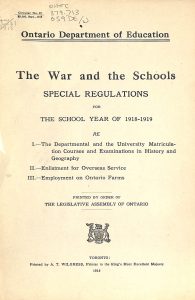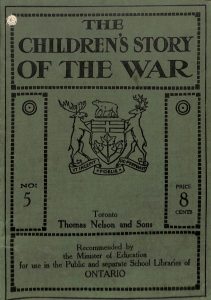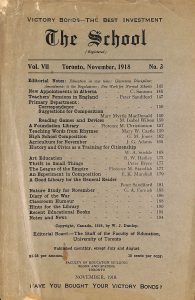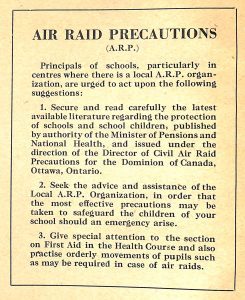Most of us remember learning about World War I and World War II in school on Remembrance Day. Have you ever wondered how schools were affected during the war? The Ontario Historical Education Collection at the OISE Library has a small collection of pamphlets, periodicals, school regulations, and other materials published during the World Wars that lend some insight into what it was like to be a student at this time in history.
 The Ministry of Education in Ontario responded to the disruption of schooling caused by the outbreak of war in 1914 by issuing special school regulations for wartime: The War and the Schools. These special regulations were updated annually and addressed, among other things, the problem presented by young men enlisting prior to completing their schooling. Pupils who enlisted were exempted from their end-of-year examinations, were permitted to write these examinations early, or were permitted to enroll in summer sessions with all related fees covered by the government.
The Ministry of Education in Ontario responded to the disruption of schooling caused by the outbreak of war in 1914 by issuing special school regulations for wartime: The War and the Schools. These special regulations were updated annually and addressed, among other things, the problem presented by young men enlisting prior to completing their schooling. Pupils who enlisted were exempted from their end-of-year examinations, were permitted to write these examinations early, or were permitted to enroll in summer sessions with all related fees covered by the government.
Enlistment had an impact on the schooling of pupils who remained in Canada as well – many of their teachers, for example, left to serve overseas. Pupils could also elect to work in the Farm Service: in response to the loss of labour on farms due to enlistment, boys and girls in Ontario schools could volunteer to work on an Ontario farm for a period of three or more months. As with pupils who enlisted to serve in the military, pupils who engaged in the Farm Service were exempted from examinations or were permitted to take their end-of-year examinations early.
 The special regulations during these years also detailed what was to be taught about the war in classrooms during these years. The material covered included the remote and immediate causes of the war as well as the events of the War itself. These regulations also required at least one question about the War be added to the end-of-year examinations in History. The precise material taught in classes was tailored to the students’ grade level and maturity. For example, it was recommended in 1915 that public school teachers use a periodical called The Children’s Story of the War which provided background information and contained detailed narratives explaining the events of the War. Teachers were also advised to supplement lessons about the war with suitable newspaper clippings and to arrange class visits to training grounds and aircraft exhibitions.
The special regulations during these years also detailed what was to be taught about the war in classrooms during these years. The material covered included the remote and immediate causes of the war as well as the events of the War itself. These regulations also required at least one question about the War be added to the end-of-year examinations in History. The precise material taught in classes was tailored to the students’ grade level and maturity. For example, it was recommended in 1915 that public school teachers use a periodical called The Children’s Story of the War which provided background information and contained detailed narratives explaining the events of the War. Teachers were also advised to supplement lessons about the war with suitable newspaper clippings and to arrange class visits to training grounds and aircraft exhibitions.
 Other resources were also made available to teachers, to facilitate the task of teaching about the war. Books discussing the War began to appear soon after war broke out, and were placed on lists of recommended books issued by the Department of Education. Publications directed toward teachers, such as The School magazine, included detailed descriptions of events of the War as well as information about initiatives to support the war effort such as War Savings Stamps. Other publications served as propaganda for the War, such as Empire Day programming in 1918, which featured descriptions of wartime events.
Other resources were also made available to teachers, to facilitate the task of teaching about the war. Books discussing the War began to appear soon after war broke out, and were placed on lists of recommended books issued by the Department of Education. Publications directed toward teachers, such as The School magazine, included detailed descriptions of events of the War as well as information about initiatives to support the war effort such as War Savings Stamps. Other publications served as propaganda for the War, such as Empire Day programming in 1918, which featured descriptions of wartime events.
Many of this publications continued in the years immediately following the War. In 1919, for example, The Great War in Verse and Prose was published. Still other materials would be published honouring those who fought in the War, such as The Roll of Honour of the Ontario Teachers who Served in the Great War, 1914-1918.
 World War II resulted in many similar documents. Special regulations were implemented for schools, curriculum guidelines for teaching about the War were published for teachers’ use, and in 1941 the Farm Service was resurrected due to labour shortages. World War II came with additional concerns as well – although Canada did not anticipate many air raids, air raid precautions were nonetheless implemented for schools. Pamphlets and booklets supporting the war effort were also heavily present in schools during World War II. Empire Day, for example, featured the war every year (as well as in 1946, in celebration of the Allies’ victory). Booklets describing key events and and outlining the ways in which Ontario schools were supporting the troops were also published to be distributed to pupils.
World War II resulted in many similar documents. Special regulations were implemented for schools, curriculum guidelines for teaching about the War were published for teachers’ use, and in 1941 the Farm Service was resurrected due to labour shortages. World War II came with additional concerns as well – although Canada did not anticipate many air raids, air raid precautions were nonetheless implemented for schools. Pamphlets and booklets supporting the war effort were also heavily present in schools during World War II. Empire Day, for example, featured the war every year (as well as in 1946, in celebration of the Allies’ victory). Booklets describing key events and and outlining the ways in which Ontario schools were supporting the troops were also published to be distributed to pupils.
A selection of items will be on display in the glass table on the ground floor of the OISE Library through the month of November.
